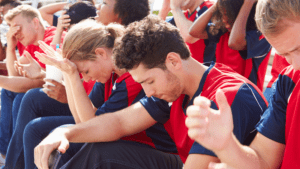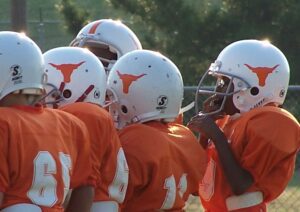The zone is different for everyone. Some athletes get amped up, and others prefer to be calm. The zone is the mental space where athletes are at their best. Some are emotionlessly intense and others are passionately in the moment, but the one universal truth about the zone is the unwavering focus that exists within. Finding it is not necessarily hard to do as long as you understand what it means and how it feels to you. However, if you are unfamiliar with it, or cannot pinpoint a time that you’ve been in it, the outside noise around your game can overtake your focus and shake your confidence.
Outside noise can come in the form of a coach yelling from the sidelines, parents or fans in the stands barking orders, opponents heckling from across the field, and even self-doubt inside your own head. If you can hear any of that, it will be tough to stay focused. If you are out of focus, it is tough to stay competitive. Finding the zone and silencing the noise are essentially one in the same, but how does one do it?
How to get in the zone and stay focused while performing
Once again, this looks different for everyone and it is an evolution in itself. Getting in the right headspace is mostly credited to the routine an athlete goes through in preparation for competition. That could be listening to certain music, using positive self-talk, becoming obsessive over a goal for that day, or even meditation. One element of a routine may help an athlete reach the zone for a while, and it may change into something else down the road. The key is to find one thing that works for you—that gets you into a confident, comfortable headspace—and to stick to it.
Imagine a stoplight. Its green light signals to go, the yellow to slow, and the red light signals drivers to stop. Imagine this light and consider each signal a different status of an athlete’s mental game:
1. Green Light
When an athlete is in the zone, their focus is purely on the objective at hand. They are negatively affected by nothing. Nothing outside of their mind and the process they are following can get in their way. While in the green, you’re at your very best. You trust in your training, and your competitiveness has taken over. Things happen naturally when you are in the zone.
2. Yellow Light
At any given moment an athlete can fall from green to yellow. A fan may be chirping from the stands, or a mistake could derail their focus. The important thing to understand about the yellow light is that it can be corrected back to green. Acknowledge that you’ve slipped out of the zone and actively work to get back into it. Once more, it’s not as hard to find the zone once you know what it is and how it feels to you. Fall back on what you know, and regain your focus to get back into “the green.”
3. Red Light
If you slip from yellow to red, you’re toast. You’ll know this has happened when your nerves creep up, you lose your sense of comfort, and you can literally hear everything. “The noise” has thus far been described as outside influences—whether intentional or unintentional—breaking up your focus. When you are on a red light, you’ve lost the ability to filter any of it. Now the opponent who is talking trash, the loud-mouth fan, and the angry coach are inside your head at the same time. At this point you are truly on your own.
The red light sounds dramatic, and it is meant to. Every athlete has been there before, and it’s important to understand your ability to find the zone, and how it leads to success. Accept your failures as opportunities to recognize a weakness. Use them to learn and gain this control of the mental game. Recognizing where you stand mentally in competition will help you to better use failures to your advantage. If you can recognize what causes them, you can actively avoid repeating them in the future.
With our 100% money-back guarantee and vetted coaches, anyone can achieve their full athletic potential. CoachUp is the safest and easiest way to find a coach for personalized training. Find your perfect coach today and become the athlete you want to be!
How useful was this post?
Click on a star to rate it!
Average rating 3.4 / 5. Vote count: 5
No votes so far! Be the first to rate this post.



